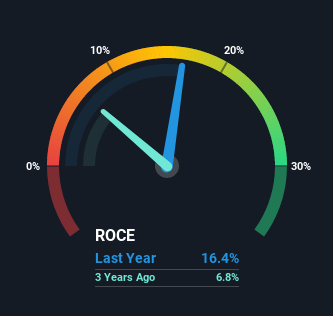
If you're looking for a multi-bagger, there's a few things to keep an eye out for. Ideally, a business will show two trends; firstly a growing return on capital employed (ROCE) and secondly, an increasing amount of capital employed. Basically this means that a company has profitable initiatives that it can continue to reinvest in, which is a trait of a compounding machine. With that in mind, we've noticed some promising trends at NZME (NZSE:NZM) so let's look a bit deeper.
Understanding Return On Capital Employed (ROCE)
For those who don't know, ROCE is a measure of a company's yearly pre-tax profit (its return), relative to the capital employed in the business. The formula for this calculation on NZME is:
Return on Capital Employed = Earnings Before Interest and Tax (EBIT) ÷ (Total Assets - Current Liabilities)
0.16 = NZ$40m ÷ (NZ$312m - NZ$70m) (Based on the trailing twelve months to December 2021).
Thus, NZME has an ROCE of 16%. In absolute terms, that's a satisfactory return, but compared to the Media industry average of 12% it's much better.
View our latest analysis for NZME

In the above chart we have measured NZME's prior ROCE against its prior performance, but the future is arguably more important. If you'd like to see what analysts are forecasting going forward, you should check out our free report for NZME.
What The Trend Of ROCE Can Tell Us
We're pretty happy with how the ROCE has been trending at NZME. The figures show that over the last five years, returns on capital have grown by 47%. The company is now earning NZ$0.2 per dollar of capital employed. In regards to capital employed, NZME appears to been achieving more with less, since the business is using 41% less capital to run its operation. If this trend continues, the business might be getting more efficient but it's shrinking in terms of total assets.
The Bottom Line On NZME's ROCE
From what we've seen above, NZME has managed to increase it's returns on capital all the while reducing it's capital base. Since the stock has returned a staggering 142% to shareholders over the last five years, it looks like investors are recognizing these changes. With that being said, we still think the promising fundamentals mean the company deserves some further due diligence.
NZME does have some risks, we noticed 4 warning signs (and 1 which is significant) we think you should know about.
While NZME isn't earning the highest return, check out this free list of companies that are earning high returns on equity with solid balance sheets.
If you're looking to trade NZME, open an account with the lowest-cost platform trusted by professionals, Interactive Brokers.
With clients in over 200 countries and territories, and access to 160 markets, IBKR lets you trade stocks, options, futures, forex, bonds and funds from a single integrated account.
Enjoy no hidden fees, no account minimums, and FX conversion rates as low as 0.03%, far better than what most brokers offer.
Sponsored ContentValuation is complex, but we're here to simplify it.
Discover if NZME might be undervalued or overvalued with our detailed analysis, featuring fair value estimates, potential risks, dividends, insider trades, and its financial condition.
Access Free AnalysisHave feedback on this article? Concerned about the content? Get in touch with us directly. Alternatively, email editorial-team (at) simplywallst.com.
This article by Simply Wall St is general in nature. We provide commentary based on historical data and analyst forecasts only using an unbiased methodology and our articles are not intended to be financial advice. It does not constitute a recommendation to buy or sell any stock, and does not take account of your objectives, or your financial situation. We aim to bring you long-term focused analysis driven by fundamental data. Note that our analysis may not factor in the latest price-sensitive company announcements or qualitative material. Simply Wall St has no position in any stocks mentioned.
About NZSE:NZM
NZME
Engages in the integrated media and entertainment business in New Zealand.
Good value with reasonable growth potential.
Similar Companies
Market Insights
Community Narratives



